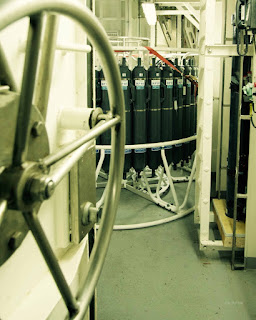I think it's time to talk a bit more about how we collect water samples, which we then analyze to reveal different properties of the water masses. We use what is called a "Conductivity Temperature Depth" rosette, or just CTD, like the one you see in the pictures below. The CTD carries a series of instruments and bottles mounted on a cylindric frame, and is attached to a wire, which enables us to receive data on real time and to deploy the instrument in the water.. and get it back.
One of the CTD rosettes in the CTD room.
The bottles are deployed open in the water and closed at defined depths (wherever we think there's an interesting structure to sample). In the lab, which here is called "Operations room", we receive data of temperature, salinity (computed from the conductivity), depth (actually, it's pressure) and many other data, as many as the instruments we mount on the frame are (such as velocity, fluorescence, oxygen, etc.). As the CTD is lowered towards the ocean floor, we can create depth profiles for each type of data. Then, by looking at these data, we can define the depths at which we wanna collect the waters (and hence close the bottles) and guide the shipmate working as winch operator throughout the cast.
During one of the CTD cast, Robin (on the right) and I (left) are checking the profiles, communicating with the winch operator to guide the activity and closing the bottles at desired depths.
During my shift I am responsible of the CTD operations. Honestly, I have a lot of fun, especially with the guys that drive the winch: they are very professional and very careful, but super funny and they never lack of making fun of my accent on the radio (apparently, it constantly shifts from sounding like french, italian or mexican..). There's just one moment that I find very stressful all the times, but fortunately I can share my stress with one of the engineers, who is responsible of all the instruments. The closer we are to the bottom of the ocean, the tenser we get. We have several instruments on board that can tell us what the expected maximum depth is at the location of the cast, but no such instruments are on the CTD. We only have a measure of the pressure at which the CTD is and we have an altimeter, which tells us how close we are to the bottom.. but it only starts to work when the CTD is at no more than 50 m from the bottom. Which is really really close. On the last 100 m, Nicole (the engineer) and I stare at the altimeter, waiting for it to kick in. This is when I wear my lucky ewok-beanie and I'm super concentrated. The thing is that we don't really wanna hit the bottom: things can crash and break, plus: it can also be dangerous. But we are a good team, and things are going really smooth.

Anna and Jodi collecting samples from the CTD bottles
Jodi and me in the CTD room, to draw samples.
Once we finish the cast, more action begins! Some of us go into the CTD room to collect samples of water from the bottles, which will then be analysed for different properties: some samples will give us an indication of how much oxygen is dissolved at the different depths, some will inform us about the content of salt, or nutrients, bacteria, chlorophyll, helium (this has the longest and the most curious sampling method!), pH, carbon, etc.. Some analyses can be done on board, some have to wait to be back on land: for those which have to wait, we make sure to store the samples in some safe place on the ship.
Kendall's working on the analysis of some water samples, in the Hydrochemistry Lab.
Unfortunately we are not always able to do a CTD cast, as the weather doesn't allow it. But when we can, we basically have the chance to get data from the interior of the ocean!! If you think about it, each cast represents a tiny point in the whole vaste ocean, such as the profiles that the floats send us. But with more and more casts, we can map a larger portion of the ocean, we can have vertical sections of the ocean, that keeps us informed of what's happening not only close to the surface, but at depth as well, and track water masses in different parts of the ocean.
Uh!! And then you get to decorate and send polystyrene foam cups down with the CTD.. which, because of the pressure they are brought to, come up all super cute and tiny.. how cool is that?! :-)
A couple of my creations.. :) A Dalek (on the left) and an octopus wrapped around a float (right). For a comparison: the penguin on the background is about 10 cm tall.
















































